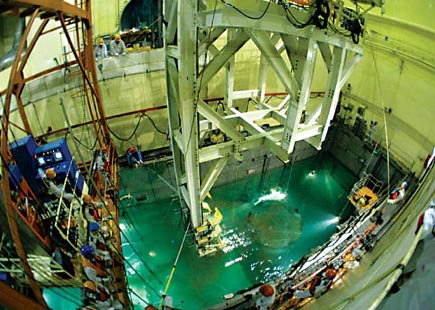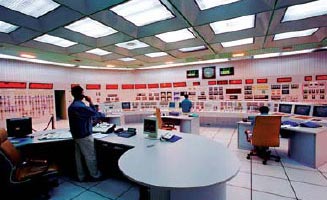Hi-tech meets human need for power
Updated: 2007-10-30 10:28
The place where the Qiantang River meets the East China Sea is a famous mountain, Qinshan, which faces Haiyan County in Zhejiang Province. Legend has it that the first emperor of China, Qinshihuang, visited Qinshan 2,000 years ago to enjoy the sunrise. He was captivated by the enchanting scenery and prompted to build a bridge linking the mountain with Shaoxing, a city in Zhejiang, which are separated by the sea.
 A bird's eye view of Qinshan nuclear power plant. |
His dream wasn't realized, but two millennia later, in 1991, China completed a more important project on the mountain named after the emperor: its first self-designed nuclear power plant.
The first nuclear power plant on the Chinese mainland signaled the embracing of nuclear energy by the country. It took more than 20 years for the country to turn the dream into reality. Today, the power plant has five nuclear reactors, which together can generate 3,000 megawatts (MW), bringing in 8 billion yuan ($ 1.06 billion) a year.
The huge nuclear reactors stand out against a gentle, lush green mountain in the background facing the vast blue sea. Neat rows of buildings contrast with the short black lines of eel-catching fishing nets on the sea. Eels, by the way, are a specialty of Haiyan and are exported to Japan in large amounts. "And thousands of bitterns break their migratory journey here every year," making the place a haven for migratory birds, says Sun Ping, a Qinshan Nuclear Power Base executive.
"China has set very strict standards on radioactive emission, but we at Qinshan are even stricter," says Pei Weinong, a senior engineer who worked at Qinshan for 18 years before being transferred to Sanmen Nuclear Power Plant in the same province two years ago.
"The level of radiation a villager living near Qinshan is exposed to in a whole year is less than that of a passenger during a flight," he said.
Qinshan radioprotection department staff sample and analyze the soil, water and air around the plant periodically, Pei says. "They check the amount of radioactive substances in sheep and poultry, too. As far as I know, no occupational disease caused by radiation has been detected among our staff," Pei says.
But many people still doubt the safety of the nuclear power plant, citing the lingering impact of Chernobyl on the people of Pripyat in Ukraine.
 Technicians at Qinshan Nuclear Power Base work on radiation supervision facilities. |
A reactor at the Chernobyl nuclear power plant exploded on April 26, 1986, causing the worst nuclear accident in the world. Since there was no containment building, a plume of radioactive smoke drifted over parts of what was then western Soviet Union and Eastern Europe, Scandinavia, the UK, and even the eastern parts of the US. It contaminated large areas, forcing evacuation and resettlement of about 340,000 people. Thirty-one people died instantly, while about 270,000 contracted various diseases, especially cancer.
Pei says a Chernobyl-like tragedy is unlikely to recur at nuclear power plants such as Qinshan. "At Qinshan, each reactor has five barriers to prevent nuclear leakage, so particular are we about safety here." The Chernobyl plant didn't have even a third barrier, he says.
The Qinshan staff have considered all possible scenarios, he says. "We can ensure radiation levels won't cross the national standard in case there's a leak."
All security-related facilities are well managed and examined on schedule, ranging from every two to eight hours. At times, the safety inspections can continue for up to day or even longer according to their importance, says Wu Bingquan, operation director of Qinshan plant's first phase (Qinshan-I), who has worked at the plant for nearly 20 years.
According to an IAEA report, more than 50 percent errors in nuclear power plants around the world are contrived. To prevent that Qinshan has laid out a series of regulations for its staff.
"For instance, when an operator issues an order on the phone, the receiver has to repeat it and let the operator check whether he/she has got the instruction right. The 'three-way communication' method is aimed at minimizing mistakes because of misunderstood pronunciation," says Wu.
At Qinshan, all operators have to adhere to a "STAR" working mechanism for security-related action, that is, they have to follow the order of "stop, think, (take) action and review", irrespective of how proficient they are. For some important actions, a second operator has to be present on the scene for examination.
People always say it's very expensive to train a pilot. "In fact, it may be more costly and time-consuming to train a nuclear power plant operator," Sun Ping says.
Because of the thoughtful management and strict execution, Wu is quite confident about security at Qinshan. "If not, how dare I take the position of operation director?"
"We see security as the life of Qinshan because we have to be responsible for the people and our country," says Chen Weiguo, head of the Qinshan Nuclear Power Base.
His words coincide with a banner hung at the door of the power plant, reminding its staff to "Never think we are the best, always consider security as priority".
As one of the main economic powerhouses and the most populous country in the world, China needs energy and environmental protection both. "At present, nuclear power is the most suitable compromise," says Zheng Mingguan, vice-president of Shanghai Nuclear Engineering Research and Design Institute, which designed Qinshan-I. His observation comes in an article submitted to an international symposium on nuclear power plants' management, organized by the International Atomic Energy Agency (IAEA) in mid-October.
A scholar with the Institute of Nuclear and New Energy Technology of Tsinghua University, Sun Libin, agrees with Zheng. "Other forms of new energy, such as wind and solar power, have a much lower energy density than nuclear power and hence, are unable to meet the tremendous power demand in China," Sun says.
Another senior scholar of the Shanghai institute, Dou Yikang, says the development of nuclear power will ease the pressure on coal-fired power plants, which at present provide more than 70 percent of China's electricity.
|
|
"Coal mining is highly dangerous and creates huge pressure on transport, not to mention the massive emission of carbon dioxide and other harmful gases," Dou says. "In this sense, nuclear energy is of great importance to sustainable development."
All power plants generate waste, but that generated by a nuclear power plant needs only 5/10000 of space compared to the trash from a coal-fired power station with the same capacity.
Moreover, no large-scale accident has been reported from a nuclear power plant since Chernobyl. This is a unique safety record in the energy industry. "Nuclear power is one of the safest energy sources. That's acknowledged throughout the world," Dou says. And that's the reason why the world is re-shifting attention to nuclear energy, which accounts for 16 percent of the electricity supplied across the globe. An October IAEA report terms it as "a major energy resource" in the global energy sector.
In China, the central government plans to increase its nuclear power capacity from about 9,000 MW-accounting for about 2 percent of the total electricity demand-to 40,000 MW by 2020. This is part of the country's long-term development plan for the nuclear power industry (2005-2020) issued last year.
The October IAEA report also says China "plans a nearly five-fold expansion by just 2020. Because China is growing so fast this would still amount to only 4 percent of total electricity (supplied)."
Zheng Mingguan's article lays out the importance of nuclear power and the role the country is likely to play in its development: "With 11 multi-type units in operation and more than 30 units under preparation... in the next 10 years, China will definitely play an important role in world nuclear power development in the early 21st century."
Qinshan Nuclear Power Base At A Glance
1970 Premier Zhou Enlai notes thrice in one year that it's time for China to start developing nuclear power plants (NPPs).
1981 State Council approves application for Qinshan's construction.
1991 The 300-MW unit of Qinshangets into grid, bringing nuclear energy to the Chinese mainland. Since then, China has become the seventh country in the world to design and construct an NPP independently.
2003 The 2×728-MW unit of Qinshan gets into grid. President Hu Jintao praises it highly two years later during an official visit to Canada, calling it "an example of successful cooperation between enterprises from China and Canada".
2004 The 2×600-MW Qinshan II, designed, constructed and operated independently by the Qinshan NPP, goes into operation. It marks a big stride forward toward nuclear power generation, with a localization rate of 55 percent.
2006 The construction of two 650 MW units starts at Qinshan II, with a construction period of 68 months. The preparation work of two 1,000-MW units at Qinshanis underway.
|
|
|
||
|
||
|
|
|
|
